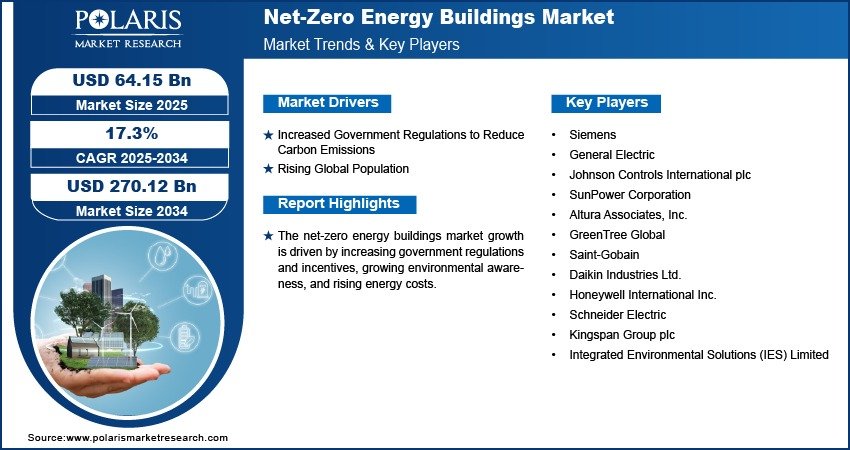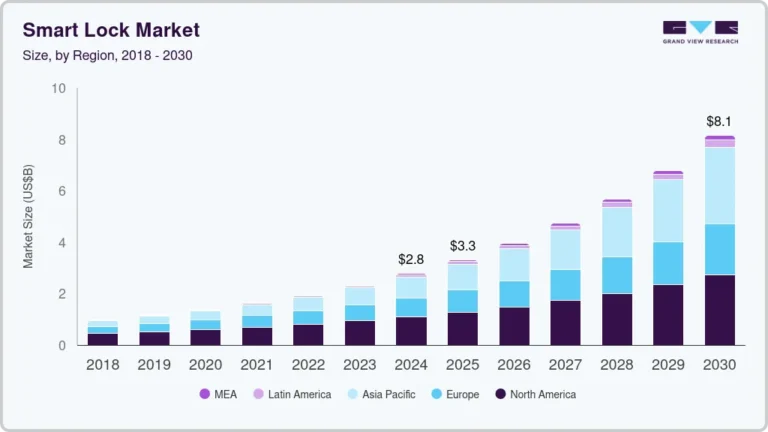Net-Zero Energy Buildings Market Projected to Reach USD 270.12 Billion by 2034 | CAGR: 17.3%

The global Net-Zero Energy Buildings Market was valued at USD 54.77 billion in 2024 and is projected to reach USD 270.12 billion by 2034, growing at a CAGR of 17.3% from 2025 to 2034. The market is gaining momentum as governments and developers increasingly focus on sustainable construction practices.
Key Market Trends
Integration of Renewable Energy + Storage
- Widespread deployment of solar PV, geothermal, and small-scale wind systems for onsite generation .
- Closer integration with battery storage, enabling demand-shifting and increased grid independence.
Smart Energy Management & AI‑Enabled Control
- Growth in intelligent building energy management systems (EMS) that use IoT, sensors, and AI/ML to optimize energy use in real time.
- Major players like Siemens are rolling out open AI-driven suites (e.g., Building X) to standardize and scale net-zero operations.
Advanced Building Materials & Envelope Innovation
- Innovations include high-performance insulation, low-E glazing, green roofs, and use of recycled or low-carbon materials, boosting airtightness and reducing thermal loss.
- Passive design strategies are gaining ground—emphasizing orientation, daylighting, and thermal mass to minimize energy needs.
Retrofits & Community‑Scale Projects
- Strong movement toward retrofitting existing structures — upgrading envelopes, adding renewables/storage, and integrating EMS—rather than only new construction.
- Shift toward district or community-scale net-zero developments, using shared energy systems to amplify efficiency and cost benefits .
Market Size & Forecast
Market Size Value in 2024 USD – 54.77 billion
Market Size Value in 2025 USD – 64.15 billion
Revenue Forecast by 2034 USD – 270.12 billion
CAGR – 17.3% from 2025 to 2034
Request for Free Sample:
Market Overview:
The net-zero energy buildings (NZEB) market refers to structures that produce as much energy as they consume over the course of a year, typically through a combination of energy-efficient design and on-site renewable energy generation. These buildings integrate advanced insulation, smart HVAC systems, LED lighting, energy management systems, and solar panels to minimize energy use and achieve sustainability goals. Driven by increasing environmental concerns, stringent government regulations, and rising demand for green infrastructure, the NZEB market is gaining momentum globally across residential, commercial, and institutional sectors.
Key Market Challenges:
One of the primary challenges facing the NZEB market is the high initial capital investment required for energy-efficient materials, smart technologies, and renewable energy installations. Limited awareness and technical expertise among developers and architects can also slow adoption. Additionally, regional variations in climate conditions affect the feasibility and efficiency of net-zero designs, making standardization difficult. Regulatory inconsistencies and lack of financial incentives in certain regions further hinder market growth, especially in developing countries where cost considerations often outweigh long-term sustainability benefits.
Market Scope:
The net-zero energy buildings market has a broad scope with growth potential across North America, Europe, Asia-Pacific, and emerging markets. It encompasses new construction as well as retrofitting of existing buildings to meet energy efficiency standards. The market is supported by global sustainability initiatives, corporate ESG goals, and advancements in building automation and renewable technologies. As urbanization accelerates and climate targets become more ambitious, the NZEB market is expected to expand significantly, transforming how buildings are designed, constructed, and operated worldwide.






